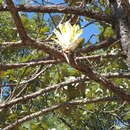Comprehensive Description
provided by North American Flora
Catopsis pendula Baker, Handb. Bromel. 155. 1889
Catofiiis paniculata Iv. Morrcn, Cut. Hort. Makoy., numen, 1883.
Plant up to 1 m. long extended; leaves about 12 in a crateriform rosette, 3-4 dui. long, cretaceous especially toward the base; sheaths elliptic, alx>ut as large as the blades and scarcely distinct from them; blades triangular, acuminate, 3-6 cm. wide; scape deflexed, much longer than the leaves; scape-bracts densely imbricate, strict, foliaceous; inflorescence amply tripinnate, 3 to often more than 5 dm. long; primary bracts like the scape-bracts, acuminate, hardly reaching the lowest flowers of the axillary branches; branches weak, elongate; spikes manyflowered, long-stipitate, the stamiuate subdense, 65 mm. long, the pistillate lax, up to 25 cm. long; floral bracts broadly ovate, obtuse, much shorter than the sepals; flowers functionally dioecious, suberect to spreading, the staminate 7 mm. long, the pistillate up to 12 mm. long; sepals strongly asymmetric, suborbicular, subcoriaceous with a broad membranaceous margin, prominently nerved, the staminate 5 mm. long, the pistillate 5-9 mm. long; petals exceeding the sepals; stamens unequal; ovary stout, ovoid; capsule up to 18 mm. long, short-beaked.
Type locality: Mexico.
Distribution: Southern Mexico, Guatemala, and Costa Rica.
- bibliographic citation
- Lyman Bradford Smith. 1938. (XYRIDALES); BROMELIACEAE. North American flora. vol 19(2). New York Botanical Garden, New York, NY
Comprehensive Description
provided by North American Flora
Catopsis mexicana L. B. Smith, Contr Gray Herb. 114:4. 1936.
Plant 6 dm. high with inflorescence erected; leaves lanceolate with practically no distinction between sheath and blade, acuminate, 4 dm. long, 7 cm. wide, flat, scarious-margined, obscurely brown-punctulate, verruculose; scape slender, arching, glabrous; its bracts erect, much exceeding the internodes, foliaceous; inflorescence subpendulous, rather densely 3-pinnate, over 3 dm. long, glabrous; primary bracts very broadly ovate, long-acuminate, much shorter than the axillary branches; spikes slenderly long-stipitate, subsecund, up to I dm. long, densely flowered; floral bracts squaraiform-ovate, about one third as long as the sepals; flowers perfect, suberect; sepals elliptic-oblong, strongly asymmetric, 9 mm. long; petals ligulate, asymmetric, white, barely exserted; styles 3, short but distinct.
Type locality: Tejupilco, Mexico [State], altitude 1340 meters. Distribution: Known only from the type collection.
- bibliographic citation
- Lyman Bradford Smith. 1938. (XYRIDALES); BROMELIACEAE. North American flora. vol 19(2). New York Botanical Garden, New York, NY
Comprehensive Description
provided by North American Flora
Catopsis hahnii Baker, Jour. Bot. 25: 175. 1887
Plant 5 dm. or more high; leaves up to 4 dm. long, bearing a slight white-cretaceous coating on the back; sheaths elliptic, longer than the blades; blades triangular-acute, 4 cm. wide; scape erect or arching; scape-bracts erect, densely imbricate, foliaceous, large; inflorescence tripinnate for half its length, densely subthyrsoid, 20-25 era. long, 7 cm. in diameter; primary bracts suberect, ovate-lanceolate, acuminate, the lower equaling or exceeding the axillary branches; secondary bracts small, ovate, about equaling the short stipes of the spikes; spikes densely flowered, 4 cm. long; floral bracts suberect, ovate-elliptic, obtuse, 7-8 mm. long, distinctly shorter than the sepals; flowers suberect, perfect; sepals asymmetric, 9 mm. long, even; petals 1 1 mm. long, white.
TypB LOCALiTv: Mexico. Distribution : Vera Cruz and Oaxaca.
- bibliographic citation
- Lyman Bradford Smith. 1938. (XYRIDALES); BROMELIACEAE. North American flora. vol 19(2). New York Botanical Garden, New York, NY
Catopsis hahnii
provided by wikipedia EN
Catopsis paniculata is a species in the genus Catopsis. This species is native to Central America and Mexico.[1][2][3][4][5]
References
-
^ a b Kew World Checklist of Selected Plant Families
-
^ Luther, Harry E. (1995). "An Annotated Checklist of the Bromeliaceae of Costa Rica". Selbyana. 16 (2): 230–234. ISSN 0361-185X. JSTOR 41759911.
-
^ Espejo-Serna, Adolfo; López-Ferrari, Ana Rosa; Ramírez-morillo, Ivón; Holst, Bruce K.; Luther, Harry E.; Till, Walter (1 June 2004). "Checklist of Mexican Bromeliaceae with Notes on Species Distribution and Levels of Endemism". Selbyana. 25 (1): 33–86. ISSN 2689-0682. JSTOR 41760147.
-
^ Smith, L.B. & R. J. Downs. 1977. Tillandsioideae (Bromeliaceae), Part II. Flora Neotropica, Monograph 14(2): 663–1492.
-
^ Huft, M. J. 1994. 9. Catopsis Griseb. 6: 142–146. In G. Davidse, M. Sousa Sánchez & A.O. Chater (eds.) Flora Mesoamericana. Universidad Nacional Autónoma de México, México, D. F.

- license
- cc-by-sa-3.0
- copyright
- Wikipedia authors and editors
Catopsis hahnii: Brief Summary
provided by wikipedia EN
Catopsis paniculata is a species in the genus Catopsis. This species is native to Central America and Mexico.
- license
- cc-by-sa-3.0
- copyright
- Wikipedia authors and editors

